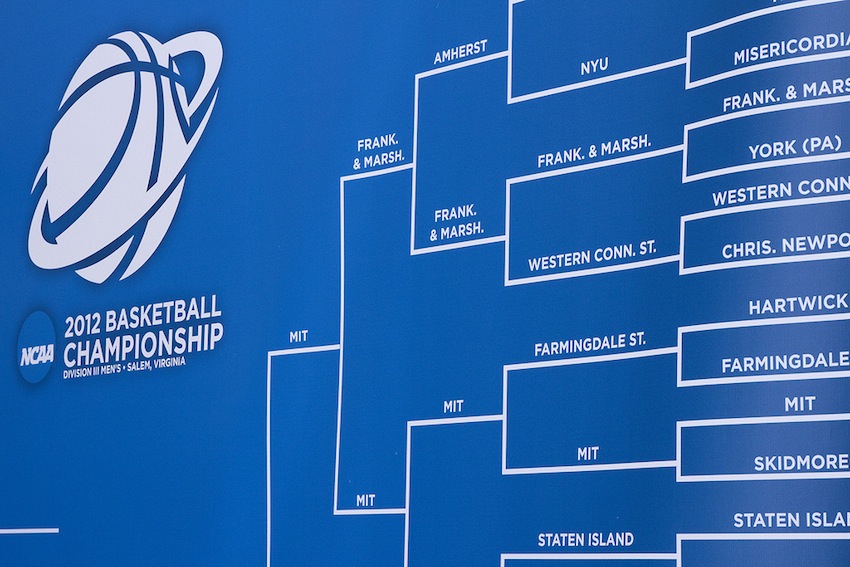Basketball Fans Can’t Find a Home Team to Root for? Try Division III

MIT Men’s Basketball NCAA Championship Weekend image by MIT Student Life on Flickr
With a struggling Celtics team and relatively unexciting prospects on the college level, Boston appears to offer little for basketball fans hoping to latch onto a local winner this winter. Maybe they should turn to Division III.
Over the past five or so years, the region has become a hub for D-III basketball. In the D3hoops.com preseason poll, three of the top 10 spots belong to Massachusetts-based schools, only the second time that has happened since D3hoops.com began its current ranking system. On the other side of the state, Amherst—the defending national champions—and Williams are powerhouses, ranked first and third, respectively, while Worcester Polytechnic Institute (WPI) clocks in at eighth. A season ago MIT received the nation’s top ranking in the same poll, though a rash of injuries would derail their season earlier than expected. This year, the Engineers of MIT (not to be confused with the Engineers of WPI, one of MIT’s biggest rival) are on the outside looking in, joining Brandeis and Tufts as greater Boston area schools receiving top-25 votes, but failing to notch a spot in the poll.
What accounts for the handful of Boston-area schools that have risen to national acclaim at the D-III level? After all, basketball might have started here, but its no longer considered much of a hotbed for breeding hoops talent. And this D-III trend toward the Northeast has not been mirrored at the Division I level. (The AP Top 25 includes just two Northeast schools, Syracuse and UConn, though both Harvard and UMass received votes in the most recent poll). Certainly, it’s a factor that Massachusetts just has a lot of Division III schools. But the level of success and the number of nationally relevant teams in the area is unprecedented.
As it turns out, coaches suggest that it’s not so much the number of schools in and around Boston that accounts for our overrepresentation, but rather the quality of those schools. Ultimately, Boston and the neighboring region are home to elite institutions, which have made a push towards athletic excellence at a time when the distinction between playing Division I and Division III basketball is at its lowest. That’s transformed Boston into the eye of the Division III basketball storm.
“I think when you’re out there trying to identify prospective student athletes, it’s been my experience that they don’t want to sacrifice one for the other [athletics or academics],” said MIT head coach Larry Anderson. “If you find that true student athlete, they want the challenge academically, athletically and they want the kind of community that they’ve dreamed about over the years. When you can put those three pillars together, it’s attractive to some people.”
And while rising athletic achievement is stereotypically thought to coincide with lower academic standards, that does not appear to be the case at MIT or other Division III schools that are using strong academics to attract more competitive athletes.
Rhode Island College coach Bob Walsh believes the drastic improvement of schools like MIT, WPI and others in the region is the combination of coaching and a changing approach to athletics at elite academic schools.
“I think somewhere along the way there might have been a shift in philosophy, or maybe it’s just the leadership at specific schools, but [they realized] it’s ok to offer high-level academics and a high-level athletic experience,” Walsh said. “I think schools have committed to achieving both.”
The sentiment was echoed by Anderson.
“We felt that if MIT could be number one in academics, we should all want to strive to be number one in basketball,” he said. “I don’t think [the school] made a commitment to do anything except be the best that we could be like we try to be on the academic side.”
But making a commitment—Anderson refers to it as a “shared vision” constructed between the University, himself and his players—is one thing; recruiting Division-I-caliber athletes is another. Here, Walsh and Brian Meehan, the head coach at Brandeis University, credit advances in internet technology and online coverage that have minimized a perceived gap between playing Division I and Division III basketball.
“I think having d3hoops.com has given D-III a little more notoriety and a new face and allowed people to follow it,” Meehan said. “We’ve developed more of a fan base for Division III through the internet.”
Of course there remains a difference between playing Division III basketball and Division I, but as Walsh put it, “college basketball in general is squeezing a lot closer to the middle … and that all creeps down to the lower levels as well.”
And as the distinctions between playing D-I and D-III basketball fade, players on the fringe of Division I are increasingly choosing to play a bigger role at top Division III schools such as Tufts, Brandeis and MIT.
“At MIT, it has been the kids making a choice whether they want a chance to play immediately—or an opportunity to play at least as a sophomore or a junior—as opposed to being an 11th- or 12th-man on some Division I teams. Some kids would prefer to have that opportunity as opposed to going to a Division I program where they may not feel it can help them achieve what they want to achieve.”
Of course location doesn’t hurt either.
“Boston is such a great draw,” said Tufts head coach Bob Sheldon. “It’s a great sports town. I say that you can go to practice and then go to a Celtics game. And we can tell our student athletes there are 46 colleges and universities inside [Route] 128 so we can play our schedule and not miss any school.”
For the scholar athletes, that’s an attractive proposition.


